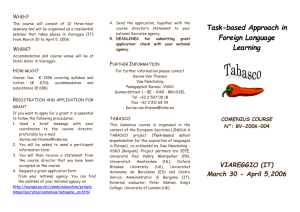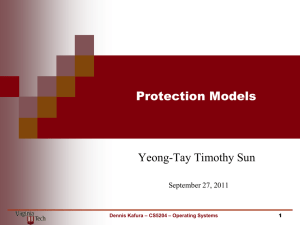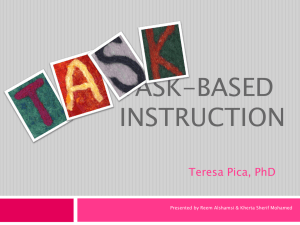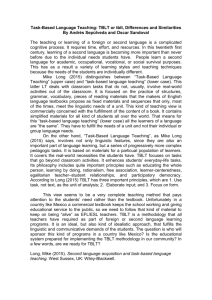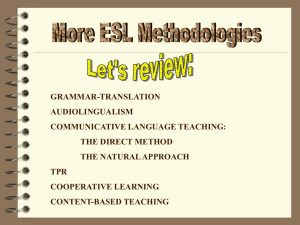teacher input that facilitates successful student output
advertisement
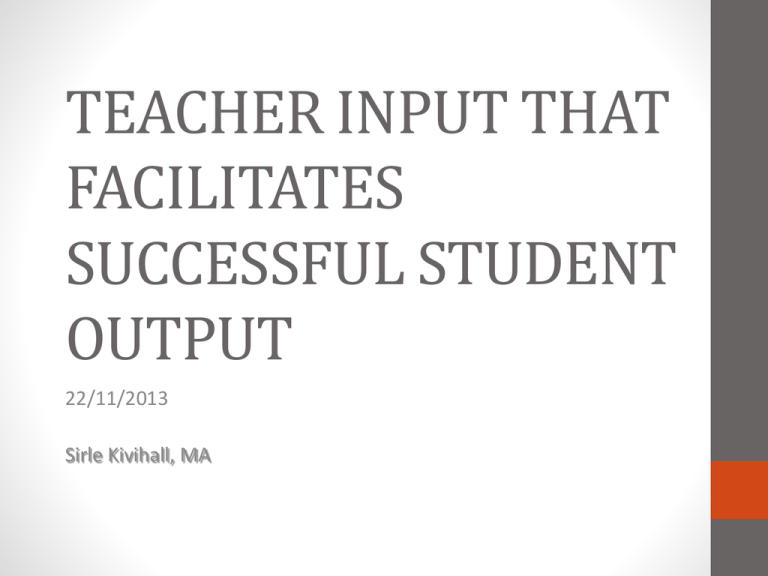
TEACHER INPUT THAT FACILITATES SUCCESSFUL STUDENT OUTPUT 22/11/2013 Sirle Kivihall, MA Topic- and task-based lessons • Teachers aim is not just fill up the students with knowledge, but encourage them to learn by doing; • Help them personalise what they learn and appreciate its usefulness. • Task-based approach is seen as the most effective and appropriate to use: Learner-centred; Provides target language exposure rather than rote learning; Requires classroom dynamics which involve the students in a socialising process. Key criteria of task-based approach 1. Classroom management classroom organisation is student-focused, students engage actively in the lessons (groups, pairs or individually), content is task-based. This encourages the students to become self-directed and responsible decision-makers, participating actively in their own learning. Key criteria of task-based approach • Staging cohesion in classroom management is very important. • Developing a well-structured lesson plan, focused on a unifying theme, topic and aims. • In a well-staged lesson, language is seen as a process rather than a product. • Much emphasis is put on vocabulary, grammar and pronunciation through practice. • Both receptive and productive skills are dealt with. Key criteria of task-based approach • Teachers need to identify activities which will lead to communicative, authentic use of language. • The think-pair-share approach, i.e. students first think of ideas individually, then discuss them in pairs before sharing with the class. Involves students more actively with the lesson content. Key criteria of task-based approach 2. Teaching materials • Authentic sources, textbooks or reference materials. • Teaching materials should be suitable for the purpose. • Engage the students’ interests. Key criteria of task-based approach 3. Motivation and responsiveness to students’ needs and interests • Presenting materials with media-intensive support. • Ensuring students’ engagement in a meaningful learning process. • Taking into account the students’ needs and interests. Students feel encouraged to pursue their own enquiries and express themselves in a supportive and productive learning environment. Key criteria of task-based approach 4. Topic-oriented lesson plans • List the topic, the aims of the lesson, the method, and materials. • Take into account the teacher-produced materials and a selection of appropriate published materials. • Outline ways in which meaning can be made accessible (visual/aural support, editing and simplifying texts, allowing groupwork, outlining plans for getting the students involved). Key criteria of task-based approach 5. Classroom dynamics • • • • • Whole-class interaction. Small group interaction. Interaction in pairs. Student-teacher interaction. Individual work. Teachers should exploit any opportunities to get their students to socialise in the classroom as this can be a very motivating process. Key criteria of task-based approach 6. Critical reflection • Examining your own particular context. • Interpreting what takes place in a lesson. • Evaluating your decisions. It brings about a deeper awareness of what you are doing and may, eventually, lead you to decide to make changes to your teaching practice. Topic- and task-based lessons o Research suggests that blocked practice leads to better shortterm performance, interleaved practice to better learning. • Blocked practice is easy to use when following coursebooks that use step-by-step building blocks’ approach. • Basing your approach around topics, texts or tasks rather than language points, you can focus on whatever language happens to come out of them. • Many items will come up again and again in later lessons, allowing you to focus on them again, leading to naturally distributed or interleaved practice. Topic- and task-based lessons o Presentation-Practice-Production is a widespread structure of a lesson. • It would be more effective to present one language point, practice another and produce the third. The students encounter new language items distributed over parts of three lessons rather than the whole of one lesson. Topic- and task-based lessons o Valuable activities • Use whole, complete texts that present interesting content (e.g. stories of scientific inventions, biographies of interesting people and articles on controversial issues). • Presenting information about other cultures – not only the cultures of those countries where English is spoken as a first language. Add to the student’s knowledge of the world. Topic- and task-based lessons o An example – a text about a boy called Lorenzo and his house which is about to be pulled down. • This article contains a boy called Lorenzo, a swamp and a bulldozer. What do you think it will be about? Students speculate and predict. They use their imagination. Topic- and task-based lessons • Find three arguments for pulling down the house and two against. Students seek evidence and present it within a logical framework, creating connections between cause and effect. • Would Lorenzo’s family be better moving out or staying? Tell your partners your decision. Students are asked to evaluate, weigh up evidence, come to a conclusion and be ready to present and defend it. Cognitive skills are being developed. Promotion of students' oral performance and communication • The ultimate aim is to help the students interact successfully. Provides students with a large amount of speaking and listening practice. Resembles real-world communication. Fosters a cooperative, more relaxed environment that supports learning. Creates more autonomous learners. Promotion of students' oral performance and communication o Techniques to invite interaction: 1. Small talk - a conversation about common topics that helps build rapport between people. When students are able to interact using small talk in the classroom, they will gain confidence in practising the same language outside the classroom. It is important for language learners to gain sociolinguistic competence in appropriate topics for small talk. • A classroom discussion on appropriate and inappropriate topics is critical. Promotion of students' oral performance and communication • Small talk can be practised using a ladder drawn on the board. • On each rung of the ladder there is a small talk topic (e.g. weather, family, sports or current events). • The students move up and down the ladder using a dice. • Each student in turn must lead a small talk discussion on the topic they land on. • After 3 to 5 minutes, the next person rolls the dice and continues the activity with a new topic. Promotion of students' oral performance and communication 2. Classroom chat – moves into substantive topics derived from a lesson-based content area, using relevant vocabulary. Conversation card activities - each student gets a card with a question or topic which must be discussed with a specified number of classmates. Corner chats - students move to specific corners of the classroom, in each of which several questions are posted. They spend a predetermined amount of time in each corner discussing the questions, and then move to another corner to begin a new discussion. Promotion of students' oral performance and communication Circle talks - students form an inner circle and an outer circle. Students in the outer circle talk for one minute on a given topic to the person facing them in the inner circle. The outer circle then rotates and students talk about the same topic with new partners. Because of the repetition, the activity provides thinking time and recycling opportunities for the students. These activities involve a great deal of interaction, focusing on fluency lowering the students’ affective filter, while simultaneously developing a sense of community in the classroom. Promotion of students' oral performance and communication 3. Problem-solving assignments – to encourage interaction and authentic use of language in the classroom. • E.g. creating advertisement for a new school café, developing a flier for a language course, listing instructions for a special recipe, drawing a poster for a movie, etc. • The overall goal is authentic language practice, not the resulting product. Students gain positive recognition, also the ones who are struggling with language, but have artistic, creative or organisational talents. Promotion of students' oral performance and communication 4. Strip stories – provide practice in negotiating meaning and encouraging fluency development. Effective because there is a correct answer, and this facilitates more negotiating and discussion. • A pair or a small group is given a picture story, which has been cut into pieces. Each picture shows a clear step in a story or process. The pictures must be put in the correct order. • A follow-up activity encouraging conversation is to have the students prepare to narrate the picture story or process to the whole class. Promotion of students' oral performance and communication 5. Dialogues – starts with controlled practice and moves towards more authentic and fluent interaction. • A cards and B cards. • The Bs find a partner from the As and practice the dialogue several times together, then find a new A partner. • After several rotations, the partners switch cards, allowing the students to practise both parts of the dialogue. • Finally, the students practise the dialogue without looking at their cards. • At this point, the focus should be on being able to communicate clearly the main message of the dialogue. Students move to automaticity of the language. Teacher behaviour that enhances student output • Why do teachers often struggle when it comes to engaging students and promoting interest in the English language classroom? • Teachers should first look at their own motivation and perceptions of learning before attempting to encourage important learning values in their students. • If teachers themselves can justify the purpose of the lesson and the value of the content, then this could provide the students with a stronger reason to come to class. Teacher behaviour that enhances student output • English language teaching has changed radically over the last generation. • Significant methodological changes (emphasis on deciding on communicative objectives rather than “talking about” the target language; helping students achieve). • The enormous technological changes. • One aspect of language teaching that remains as important as ever, i.e. patience. Teacher behaviour that enhances student output 1. Try to imagine what it is like to be your student • Impatience derives from a compulsive preoccupation with our own thoughts, feelings and intentions, i.e. we detest operating at a speed that is different from our own. • Instead we should engage in a more empathic style of communication. • Empathic listening should help us rid us of our impatience and allow us to teach much better. Teacher behaviour that enhances student output 2. Don’t move your body around nervously • If you are constantly pacing up and down the classroom, you will cease to be able to enter into the individual worlds of your students. 3. Be prepared not to meet the learning objectives • Sometimes students are not in the psychological state of readiness to learn what you want them to learn. • This does not signal defeat for the teacher; it’s just the way people learn. Teacher behaviour that enhances student output 4. Don’t intervene before a “learning opportunity” has definitely passed • Sometimes a teacher’s anxieties make it very difficult to listen to a student struggling over a word, phrase, or a longer utterance. Silences are often considered to be the enemy. • Students need time to begin, self-correct, reformulate and finally produce a piece of English which reflects their best efforts. • To jump in before this process is realised is to rob them of a valuable learning opportunity. Teacher behaviour that enhances student output • Many teachers find that at times during their lessons they tend to echo their students. • It is not considered beneficial to enhancing student output. Why? 1. 2. 3. 4. 5. Because students stop listening to each other; Students make no effort to speak; Interaction patterns become teacher-centred; Teacher Talking Time increases; There is less time for other activities. Web tools that have potential for the language classroom • PowerPoint is one of the most frequently used technologies in education for giving presentations and talks. • A visually more appealing alternative for PowerPoint is Prezi. • It is being based on the idea of brainstorming and connecting the ideas to each other. • You create an “animation path” which gets you from one idea to another, forming a kind of network. Web tools that have potential for the language classroom • You create an account online (the basic one is free) and then all your Prezis are accessible from your account. • Here are some help videos for using Prezi: • For novice users www.teachertrainingvideos.com/prezi1/index.html • For more advanced users www.teachertrainingvideos.com/prezi2/index.html Web tools that have potential for the language classroom • Another tool, which has great potential for the ELT classroom, is Present.Me. • It allows teachers or students to upload Word documents, PDF files or a set of PowerPoint slides and add their voice or video to them. • The document will appear on the left-hand side of the screen and the video on the right. • It is ideal for teachers who want to produce content that students can access outside the classroom, e.g. lectures, minipresentations, vocabulary or grammar practice etc. Web tools that have potential for the language classroom • Here is a training video: http://www.teachertrainingvideos.com/presentme/index.html • And an example video: https://present.me/view/47956-wallwisher-activity-feedbackreflection • Present.Me requires a good Internet connection, but if you are lucky to have one, it is an excellent tool. Teacher as the material/task-designer • The contemporary educational setting has considerably widened the spectrum of roles the teachers have. • There is no such thing as an ideal course book, which would satisfy all our students’ and our needs. • In order to offer students the kind of practice that they actually require is to compile practice materials for them. • The Internet offers us limitless sources of materials that we can exploit as basis for our tailor-made tasks. Teacher as the material/task-designer • An example of a set of extra practice tasks triggered by the New Headway Upper-Intermediate book and the topic treated in the twelve units of this coursebook. Thank You! VIDEO CLIPS o Smack the Pony • English as a foreign language http://www.youtube.com/watch?v=3iJ9gnt7wNo • Translator http://www.youtube.com/watch?v=3L_03TMOU_s • Noor sportlane Toomas Peterson inglise keelt rääkimas. http://igav.ee/feil-noor-sportlane-toomas-peterson-inglisekeelt-raakimas/10493/ Sources used • Saltanat Meiramova “From observation to practice” / English Teaching Professional, Issue 87 July 2013 / p. 58-59 • Eric Atkinson “What exactly are we doing here?” / English teaching Professional, Issue 88 September 2013 / p. 4-6 • Mary Cerutti, Lydia Guill, Cheri Pierson, Moriah Sharp “Invitation to interaction” / English teaching Professional, Issue 87 July 2013 / p. 12-15 • Paul Bress “Patience is a virtue” / English teaching Professional, Issue 87 July 2013 / p. 11 • Nicholas Northall “Echo, echo, echo …” / English teaching Professional, Issue 88 September 2013 / p. 24 • Russell Stannard “Webwatcher” / English teaching Professional, Issue 87 July 2013 / p. 63 • Russell Stannard “Webwatcher” / English teaching Professional, Issue 88 September 2013 / p. 63
